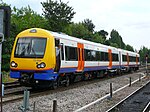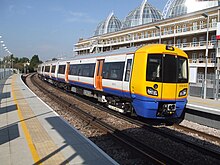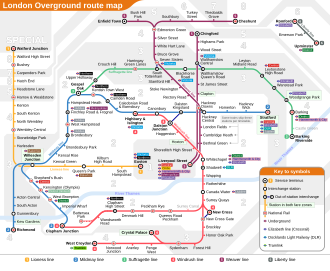London Overground
| London Overground | |
|---|---|
 
|
|
| Basic information | |
| owner | Transport for London |
| Concession and duration |
London Overground November 13th 2016 - May 2024 |
| operator | Arriva Rail London |
| statistics | |
| fleet | 96 |
| Train stations | 112 (10 managed) |
| Main regions | Greater London ; Hertfordshire |
| Secondary regions | |
| website | |
| tfl.gov.uk/modes/london-overground | |
| London Overground | |
|---|---|
| Opening: | November 11, 2007 |
| Gauge: | 1435 mm |
| Route length: | 86 km |
| Lines: | 9 |
| Passengers: | 140,000,000 |
London Overground is the name of a S-Bahn -like railway network in the British capital London , which has been in operation since November 11, 2007. The operating company is Arriva Rail London , which handles passenger transport on six lines on behalf of the umbrella organization Transport for London (TfL). The network includes routes taken over by the railway companies Silverlink and Abellio Greater Anglia , as well as a former underground line .
The route network consists mainly of railway lines that circumnavigate central London. In total, the overground routes run through 21 boroughs and South Hertfordshire. The largest part is in the Travelcard tariff zone 2. As the name suggests, the routes are almost entirely above ground . However, a section of the East London Line runs in a covered incision and through the Thames Tunnel , the world's oldest railway tunnel crossing a river.
history
planning
Rail passenger transport in the UK is operated by a number of railway companies who acquire one or more franchises which are collectively marketed as National Rail . The London Underground operated by TfL is not part of this system. In 2003 there was a first attempt to combine National Rail's rail transport in London under one umbrella brand . TfL introduced the Overground Network brand , with uniform information displays, station signage and network maps on selected routes in south London. Although this pilot was branding only , it was the first time TfL had a visible impact on National Rail's London offerings.
In 2004 the Department of Transport announced a review of the UK railways. As part of this review, TfL proposed the creation of a London Regional Rail Authority that would give TfL authority over rail traffic in and around Greater London . After two years of negotiations, Minister of Transport Alistair Darling announced on February 20, 2006 that TfL would take over the Silverlink Metro franchise . On September 5, 2006, TfL presented the new brand name "London Overground" and at the same time confirmed that the East London Line to be extended will be included in the new concept.
implementation
The franchise became the property of TfL on November 11, 2007. The following day the official handover ceremony took place at Hampstead Heath Railway Station in the presence of Mayor Ken Livingstone . The handover was accompanied by a marketing campaign. TfL then began to significantly improve the offer. This included increasing the frequency, improvements to the infrastructure, staffing all train stations and introducing new rolling stock and the Oyster Card .
As part of a program to introduce four-car trains on the overground network, the North London Line was closed from February 20 to May 31, 2010 between Gospel Oak and Stratford stations . This was necessary to enable the installation of a new signaling system, renewal of tracks, refurbishment of some stations and to extend 30 platforms. The work continued until May 2011, which resulted in reduced operations and complete closure on Sundays.
The East London Line has been part of the Overground network since April 27, 2010. The route was extended north from Whitechapel over the Kingsland Viaduct to Dalston Junction . Four weeks later, on May 23, 2010, extensions to Crystal Palace and West Croydon followed in the south , mainly on existing routes. Until December 2007, the East London Line was part of the London Underground network and was then closed for almost two and a half years for renovation work. On February 28, 2011, another extension from Dalston Junction to Highbury & Islington was added to the north . This creates a link with the North London Line, the Victoria Line and the Northern City Line .
The second expansion phase of the East London Line opened on December 9, 2012. It includes an extension from Surrey Quays along the South London Line to Clapham Junction . This created a ring line around central London. A railway line between Surrey Quays and Peckham, which has not been in operation since 1911, is used in part.
On May 31, 2015, London Overground took over the suburban trains from Liverpool Street to Chingford, Enfield Town and Cheshunt, as well as the shuttle line between Upminster and Romford from Abellio Greater Anglia .
Similar to the Night Tube on the underground, night traffic ( Night Overground ) is also to be set up on London Overground . As of December 15, 2016, trains between New Cross Gate and Dalston Junction have been operating all night on weekends. As of February 23, 2018, operations were extended from Dalston Junction to Highbury & Islington.
operator
The London Overground was operated by the private company London Overground Rail Operations (LOROL) on behalf of TfL until 2016 . LOROL was a joint venture in which MTR Corporation and Arriva each held half. Following the example that had already been used for the Docklands Light Railway , TfL had put out a tender for the operational management. In contrast to National Rail's franchises, TfL would set the fares and timetables and procure the rolling stock .
Govia , MTR Laing (joint venture of MTR Corporation and Laing Rail), the previous operator National Express Group and the Nederlandse Spoorwegen participated in the tender . In December 2006, Govia and MTR Laing entered the second round of tenders and on June 19, 2007, TfL announced that MTR Laing had been awarded the contract. The operating contract runs for seven years with an option for two more years. In December 2007, the Henderson Group announced that it would get out of the railroad business. It sold its subsidiary Laing Rail in April 2008 for around 70 million euros to Deutsche Bahn . Through a further restructuring, operations were transferred to their subsidiary Arriva.
According to the next tender, the London Overground has been operated by Arriva Rail London since November 13, 2016 , which previously held 50% of the current operating company.
Route network
The routes of the London Overground are integrated into the inter-company route network of National Rail and also appear on the route network map of the underground.
The network includes the following routes:
| line |
stretch |
Remarks |
|---|---|---|
| East London Line | Highbury & Islington - West Croydon / Crystal Palace ; Dalston Junction - New Cross | Non-stop night service on weekends between Highbury & Islington and New Cross Gate. |
| Gospel Oak – Barking railway line | Gospel Oak - Barking | |
| North London Line | Richmond - Stratford | (the easternmost section to North Woolwich was closed in 2006 and is now partially used by the Docklands Light Railway ) |
| Watford DC Line | Watford Junction - London Euston | |
| West London Line | Clapham Junction - Willesden Junction | |
| South London Line | Highbury & Islington - Clapham Junction | |
| Seven Sisters Line | Liverpool Street - Enfield Town and Cheshunt | |
| Chingford Line | Liverpool Street - Chingford | |
| Romford to Upminster Line | Pendulum line between Romford and Upminster with a stopover |
The Seven Sisters and Chingford Lines are also known as Lea Valley Lines .
There are a number of reasons why TfL considered direct control of these railway lines useful:
- Although the overground network covers large parts of London, there is a certain concentration of routes in the northeast of the city and of trains to Stratford, which was particularly important in view of the 2012 Summer Olympics being held there .
- The routes run through less affluent areas of the city and the greatly improved offer is seen as part of an urban redevelopment process.
- The North London Line and the Gospel Oak – Barking railway were considered run down and did not achieve their full potential.
As of May 2015, the following operating procedure exists:
| route | Cycle (trips per hour) | Depot | vehicle |
|---|---|---|---|
| East London Line | 4 Dalston Junction - West Croydon 4 Highbury & Islington - Crystal Palace 4 Dalston Junction - New Cross 4 Highbury & Islington - Clapham Junction |
New Cross Gate TMD | 378 Electrostar series |
| North & West London Line | 4 Richmond - Stratford 2 Clapham Junction - Stratford 2 Clapham Junction - Willesden Junction (Stratford during peak hours ) |
Willesden TMD | |
| Watford DC Line | 3 London Euston - Watford Junction | ||
| Gospel Oak - Barking | 4 Gospel Oak - Barking | 172 Turbostar series | |
| Seven Sisters Line | 2 London Liverpool Street - Enfield Town 2 London Liverpool Street - Cheshunt |
Ilford TMD Chingford siding |
Series 315 , Series 317 |
| Chingford Line | 4 London Liverpool Street - Chingford | ||
| Romford - Upminster | 2 Romford - Upminster | Ilford TMD Gidea Park siding |
vehicles
Originally, trains of the British Rail Classes 150 , 313 and 508 were also used.
| Existing vehicles | |||||||
|---|---|---|---|---|---|---|---|
| model series | image | Type | V / max |
Number of cars |
number | Seat layout | Construction year |
| British class 172 |

|
Railcar (diesel) | 160 km / h | 2 | 8th | 2 + 2 | 2010 |
| British class 315 |

|
Railcar ( electric ) | 121 km / h | 4th | 17th | 2 + 3 | 1980-1981 |
| British class 317/7 |

|
Railcar (electric) | 161 km / h | 4th | 8th | 2 + 2 | 1981-1982 |
| British class 317/8 |

|
Railcar (electric) | 161 km / h | 4th | 6th | 2 + 3 | 1981-1982 |
| British class 378/1 |

|
Railcar (electric) | 120 km / h | 5 | 20th | longitudinal | 2008-2011 |
| British class 378/2 |

|
Railcar (electric) | 120 km / h | 5 | 37 | longitudinal | 2008-2011 |
|
|
|||||||
Future development
East London Line
After the reactivation of passenger traffic via Primrose Hill, the trains of the East London Line could be run to Willesden Junction.
Watford DC Line
Plans to extend the Bakerloo Line beyond Harrow & Wealdstone on the existing route to Watford Junction (as was the case from 1917 to 1982) have in principle been approved, but no time horizon has yet been set. If this is implemented, the entire route between Queen's Park and Watford Junction will be transferred to London Underground. In this case, the overground trains would be routed over the route via Primrose Hill , which is currently not used for passenger transport. This would allow direct trains between Queen's Park and Stratford. The section towards Euston would be closed to local passenger traffic.
Gospel Oak - Barking
In addition to platform extensions, conversions are also under discussion at Gospel Oak station to extend the overground trains from Barking via the North London Line (NLL) to Willesden Junction and then integrate them into the train route of the West London Line to Clapham Junction. So far, the line from Barking in Gospel Oak ends at a head platform, direct freight trains to the North London Line bypass the station and only join the NLL at Hampstead Heath. The extension of the Overground to Dagenham Dock or even Rainham station is also under discussion.
Takeover of further lines from National Rail
Plans are also currently under discussion to move railway lines in the Surrey and Kent areas to London Overground.
Web links
- London Overground website
- London Overground Rail Operations (operating company)
- Detailed project description
- BahnInfo regional. History of the London S-Bahn
Individual evidence
- ^ London Overground - Facts and Figures . Transport for London website (Facts & Figures), accessed November 3, 2015
- ^ London Overground - Facts and Figures . Transport for London website (Facts & Figures), accessed November 3, 2015
- ^ Overground Network. Transport for London, 2006, archived from the original on October 3, 2003 ; accessed on May 20, 2010 (English).
- ^ Bob Kiley outlines proposals for London Regional Rail Authority. Transport for London, March 23, 2004, accessed May 20, 2010 .
- ^ Announcement by Alistair Darling in the House of Commons. Hansard , February 14, 2006, accessed May 20, 2010 .
- ^ Creating London Overground. (PDF; 1.6 MB) Transport for London, November 11, 2007, accessed on May 20, 2010 (English).
- ↑ London Overground to close from Gospel Oak to Stratford as part of £ 326m upgrade to deliver longer, more frequent trains. Transport for London, February 16, 2010, accessed May 20, 2010 .
- ^ Introducing London Overground - a new era for London Rail. Transport for London, September 5, 2006, archived from the original on January 29, 2010 ; accessed on May 20, 2010 (English).
- ^ London orbital rail network complete. The Rail Engineer, November 2, 2012, accessed January 7, 2013 .
- ↑ More EMUs for London Overground . Railway Gazette 9 April 2014
- ^ A b London Overground Night Service. Transport for London , accessed December 16, 2017 .
- ↑ Milestone reached in transformation of London's overland rail network as operator is announced. Greater London Authority , June 19, 2007, accessed June 20, 2006 .
- ↑ Acquisition in Great Britain. Manager Magazin , January 21, 2008, accessed May 20, 2010 .
- ↑ Travel boost for Londoners as Chancellor and Mayor confirm expansion of night time services & new WiFi for the Tube. Department for Transport, February 20, 2015, accessed February 20, 2015 .
- ↑ Response to Network Rail's Draft Cross-London Route Utilization Strategy. (PDF; 531 kB) Transport for London, 2006, accessed on May 20, 2010 (English).
- ^ London's Forgotten Railway: The Transport Committee's Review of the North London Railway. (PDF) (No longer available online.) Greater London Authority, March 2006, archived from the original on July 19, 2011 ; accessed on May 20, 2010 (English). Info: The archive link was inserted automatically and has not yet been checked. Please check the original and archive link according to the instructions and then remove this notice.
- ↑ London Underground timetables. In: tfl.gov.uk. Transport for London , accessed June 3, 2015 .
- ^ East London Line Extensions, Future. www.alwaystouchout.com, November 9, 2006, accessed July 16, 2010 (English).
- ^ The London Overground Network. BBC, December 7, 2006, accessed July 16, 2010 .
- ↑ London Overground Rail and Orbi, Future possibilities. www.alwaystouchout.com, February 12, 2008, accessed July 16, 2010 (English).
- ^ The London Overground could take over train services to Kent and Surrey. The Independent, October 16, 2015, accessed March 14, 2016 .




